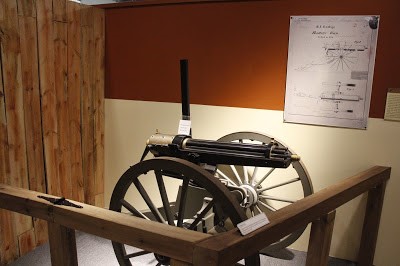Controversy in the Museum
March 21, 2016

|
|
|
Steven King, Curator of Collections |
Guests have asked before about controversial aspects of the Museum. We asked our Curator of Collections, Steven King, what he thinks would be most controversial about the artifacts in the Museum.
Some of the more controversial things we have in the Museum are reproductions. Many people would expect genuine artifacts in a museum, not reproductions. There are actually different types of reproductions and different ways they are used. For example, in our museum, the Gatling gun is a reproduction. We call it a replica because it was made after the same plans as an original Gatling gun but it was made recently, as opposed to being from the late 1800’s. While such a reproduction is not a real artifact, it is faithful to the original and it still is a wonderful piece that can be used to show the advancement of technology to our guests. On the other hand, there are reproductions that we call fakes.
|
A fake is an object that was made to look like an ancient artifact and was sold as such. We have a few of these in the Museum as well. Matter of fact, there is a case in our Pre-Hispanic exhibit that showcases reproductions, some of which are fakes. We learned that these objects were fakes when we renovated the Pre-Hispanic exhibit. We had an expert in Pre-Hispanic cultures, Dr. John Hoopes from the University of Kansas, come and look at some of our artifacts and identified some of them as fakes. We put some of the fakes in a case to let guests know that museums and collectors always have to be wary of artifacts and do proper research in order to make sure they acquire a genuine piece of history. Fakes can be particularly controversial because sometimes, a reproduction is not made as a fake but is sold as a fake later on. For example, someone living in Central America makes a pot after the style of a Pre-Hispanic culture and sells the pot to a tourist, not as a genuine artifact, but as an accurate reproduction. Years later, the tourist forgets the exact origin of the pot and assuming that it must be an artifact, because it looks so much like other genuine artifact, sells it as a genuine Pre-Hispanic pot. Not only can such a scenario happen, some people deliberately take advantage of it by either being vague about the origin of a pot or by knowingly buying reproductions and then turning around and selling them as genuine articles.
There is another type of reproduction that is in the Museum. That is a facsimile, which is basically just a copy. We are capable of creating these in the Museum as they are simply faithful copies of documents. Their main purpose is to display the document while also protecting them. Documents are very fragile and can be easily damaged if they are not handled or displayed carefully. One way to protect them is to create facsimiles, keep the original documents in storage, and put the facsimiles on display. That way, we can show the document to the public while keeping the original safe and protected for the future and for research. Sometimes, we also bring the originals out for special occasions. Whether the original is on display or facsimile is used in its place, the curators at the Museum work hard to guarantee our artifacts are treated with the utmost respect and care to ensure they will available for future generations to enjoy as well.
For more information about the exhibits and artifacts on display at the Museum, please visit our website or give us a call at 316.263.1311.
